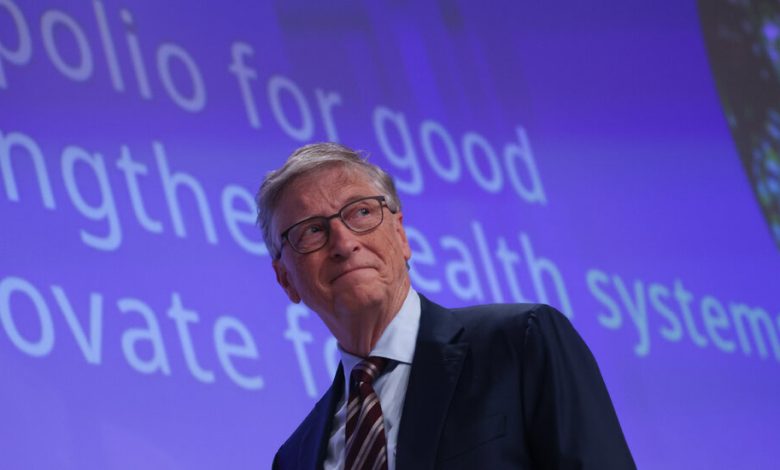He Says He’s Doing Good. This Author Strongly Disagrees.

THE BILL GATES PROBLEM: Reckoning With the Myth of the Good Billionaire, by Tim Schwab
A quarter-century ago, Bill Gates became an international symbol of greed, arrogance and hubris for his no-holds-barred leadership of Microsoft.
Then, not long after the U.S. government sued the company for abusing its monopolistic powers, Gates underwent a transformation. He set aside his business ambitions and devoted his energies to giving away his vast fortune. He went from being a corporate villain to a world-saving philanthropist — or so the story goes.
In his new book, “The Bill Gates Problem,” the journalist Tim Schwab dismisses that makeover as a fanciful fable. The real Gates, according to Schwab, remains a power-hungry, narcissistic control freak, and the sprawling Bill and Melinda Gates Foundation is little more than a vehicle for him to accumulate and deploy influence on a far greater scale than he could as a mere billionaire software mogul. It is profoundly undemocratic and entrenches inequality, Schwab argues.
Gates and his then-wife established their foundation around 2000 to tackle some of the world’s most pressing challenges, including public health, family planning, hunger and education. Armed with roughly $67 billion, the foundation is better equipped to attack disease and malnutrition than many governments.
But the foundation doesn’t simply dole out Gates’s money to worthy causes, according to Schwab. Gates exerts control. His “unyielding belief in himself, that he is both right and righteous in everything he does,” has led him to think that he and only he knows how best to tackle the world’s most complex problems. The foundation has thrown its considerable weight behind causes that some experts don’t like, such as techniques to increase agricultural yields, and that others view as low priorities, like trying to eradicate polio.
One of the book’s most compelling sections is about the foundation’s support for family planning. Gates’s preferred method of contraception is a hormone implant that gets inserted into women’s arms and prevents pregnancy for up to five years. The foundation struck a deal with drug companies to encourage them to sell tens of millions of these implants at steep discounts. With the market flooded, health clinics in countries like Malawi and Uganda began resorting to “hard-sell tactics” to push women to accept implants that they didn’t want. Schwab describes it as a form of eugenics-inspired coercion.
While Schwab allows that Gates has some good intentions and that the foundation has saved some lives, he documents how it tends to exaggerate or even concoct data about the impact of its work, including widely cited figures about just how many lives it has actually saved.
And Schwab catalogs missed opportunities to do more. For example, the foundation had agreements with drug and health care companies that entitled it to license for free whatever the companies produced with the foundation’s money. Why, Schwab asks, didn’t the foundation insist that some of these companies donate their vaccines and other products and equipment to poor countries?
These are reasonable questions, and Schwab makes a strong case, based on years of reporting, that under the direction of a humbler man the Gates Foundation would probably be a more effective force for good.
The problem is that Schwab is rarely content to let the facts speak for themselves. Page after page devolves into insinuation and screeds against capitalism. And Schwab’s palpable anger toward the “dead-eyed,” “bleating” Gates at times left me questioning the reliability of his narrative.
He alternately bashes the foundation for spending too much money and being too stingy. He bemoans its imperiousness with vaccine development, then complains that it didn’t do more to create vaccine-manufacturing facilities in poorer countries. He argues that the foundation’s billions would be better handled by democratically elected governments — and then criticizes the foundation for donating large sums to national and local governments.
In India, we learn about the foundation’s approach to combating H.I.V. and AIDS by, among other things, distributing condoms. Schwab paints this as destined to fail because it doesn’t change people’s underlying behavior or address the root causes of the crisis. But he grudgingly cites public health officials saying the foundation’s work saved lives. Schwab falls back on a squishier argument that the foundation might be “displacing the government.”
The same with the fight against malaria, a Gates Foundation priority. Schwab criticizes the foundation’s focus on vaccines as a “magic” solution and grumbles that “under the foundation’s leadership, progress against malaria has leveled off.” But he concedes that the foundation’s billions of dollars in donations have helped pay for mosquito nets that have been indispensable in the campaign against the disease.
I found Schwab’s casual smears of other journalists to be especially distasteful. He notes that the foundation has donated money to many nonprofit investigative news organizations. Then he suggests that journalists at those outlets have been carrying water for Gates. His evidence of this, when it exists at all, is scant. For example, he singles out a public radio show for shaming because it “does not appear ever to have sought to hold Bill Gates or the Gates Foundation accountable.” (More fairly, Schwab criticizes The New York Times for initially failing to disclose that a pair of contributors who had written favorably about the Gates Foundation ran an organization that was largely bankrolled by it. Also, disclosure: Two of my colleagues at The Times are working on their own books about Gates.)
Near the end of his book, Schwab notes that readers might wonder, “How should someone like Bill Gates spend his philanthropic dollars?” It’s true — I was wondering exactly that.
Schwab deflects. He argues that it is corrosive for any one person to possess such financial power. He suggests Congress could force the Gates Foundation “to act in a more charitable manner,” or perhaps outsiders could set up an independent oversight board, consisting of teachers, students, doctors and patients from poor countries, “to make sure that Bill Gates cannot single-handedly control how the foundation’s money is spent.”
These are interesting (if utopian) ideas. But Schwab’s inability to answer his own question about how Gates should spend his money left me unsatisfied. Billionaires exist. Absent viable alternatives, isn’t it better for the world if they give away their money rather than hoard it?
THE BILL GATES PROBLEM: Reckoning With the Myth of the Good Billionaire | By Tim Schwab | Metropolitan | 484 pp | $33.99





